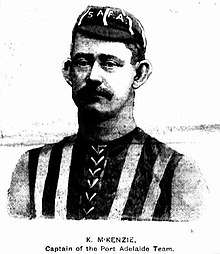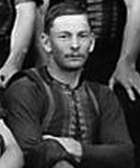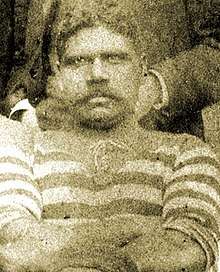Port Adelaide Football Club
Port Adelaide Football Club is a professional Australian rules football club based in Alberton, South Australia. The club's senior team plays in the Australian Football League (AFL), where they are nicknamed the Power, whilst its reserves team competes in the South Australian National Football League (SANFL), where they are nicknamed the Magpies. Port Adelaide are the oldest professional sporting club in South Australia and the fifth-oldest club in the AFL. Since the club's founding on 12 May 1870, the club has won 36 South Australian league premierships, including six in a row, records which are unequaled in the SANFL or AFL. The club also won the early 20th century Champions of Australia competition on a record four occasions.[3][4] After successfully obtaining a licence in 1994 the club began competing in the AFL in 1997, and subsequently added the 2004 AFL premiership to its list of achievements. Port Adelaide is the only pre-existing non-Victorian club to have entered the AFL.
| Port Adelaide Football Club | ||||
|---|---|---|---|---|
 | ||||
| Names | ||||
| Full name | Port Adelaide Football Club Limited[1] | |||
| Motto | We Are Port Adelaide[2] Never Tear Us Apart | |||
| 2019 season | ||||
| Home-and-away season | 10th | |||
| Leading goalkicker | Connor Rozee (29 goals) | |||
| Club details | ||||
| Founded | 12 May 1870 | |||
| Colours | Black White Teal Silver | |||
| Competition | AFL: Senior men SANFL: Reserves men | |||
| Chairman | David Koch | |||
| CEO | Keith Thomas | |||
| Coach | AFL: Ken Hinkley SANFL: Matthew Lokan | |||
| Captain(s) | AFL: Tom Jonas SANFL: Cameron Sutcliffe | |||
| Premierships | AFL (1)Championship of Australia (4)SANFL (36) SA Patriotic League (2)SANFL merger league (1) | |||
| Ground(s) | AFL: Adelaide Oval (53,583) SANFL: Alberton Oval (17,000) | |||
| Former ground(s) | Football Park (1974–2013) | |||
| Training ground(s) | Alberton Oval | |||
| Uniforms | ||||
| ||||
| Other information | ||||
| Official website | portadelaidefc.com.au | |||
Club history
1870–1876: Formation years


Right: 13 May 1870 excerpt from the South Australian Register proclaiming the founding of the 'Port Adelaide Cricket and Football Club' whilst also announcing the club's first training session.
By the late 1860s Port Adelaide's river traffic was growing rapidly. The increasing economic activity around the waterways ultimately resulted in a meeting being organised by young Port Adelaide locals John Rann, Mr. Leicester and Mr. Ireland with the intention to form a sporting club to benefit the growing number of workers associated with the wharfes and surrounding industries.[5] As a result of their meeting the Port Adelaide Football Club was established on 12 May 1870 as part of a joint Australian football and cricket club. The first training session of the newly formed club took place two days later.[6] The Port Adelaide Football Club played its first match against a newly established club from North Adelaide called the Young Australian. The club's first home ground was the family property of inaugural club president John Hart Jr in Glanville. John Hart Sr would become premier of South Australia the week following the first match.[7] During these early years, football in South Australia was yet to be formally organised by a single body and as a result there were two main sets of rules in use across the state. Port Adelaide's main opponents during the years prior to the foundation of a governing body for the code in South Australia were the now defunct Kensington and Old Adelaide club. The rules of the Old Adelaide club, which more closely resembled the rules used in Melbourne at the time, were ultimately adopted across Adelaide in 1876.
1877–1889: SAFA founder, Adelaide Oval, Alberton Oval and first premiership
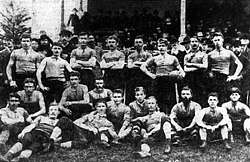
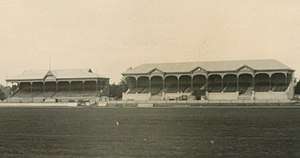
Bottom: In 1889 Port Adelaide played Norwood in the first "Grand Final" due to their identical minor round records. Port Adelaide defeated South Melbourne for the 1890 Championship of Australia. Both matches were played at Adelaide Oval, pictured in 1889.
In 1877, Port Adelaide joined seven other clubs to form the South Australian Football Association (SAFA), the first ever governing body of Australian rules football.[8] For the first few seasons in the SAFA the club competed in magenta guernseys and white shorts.[9]
In 1878, Port Adelaide hosted its first game against the recently established Norwood Football Club with the visitors winning 1–0. A rivalry between these clubs would soon develop into one of the fiercest in Australian sport (See Port Adelaide–Norwood SANFL rivalry).[10]
In 1879, the club played reigning Victorian Football Association (VFA) premiers Geelong at Adelaide Oval in what was Port Adelaide's first game against an interstate club.
In 1880, Port Adelaide moved to Alberton Oval which remains to this day the club's training and administrative headquarters. In 1881, Port Adelaide played its first game against Carlton at Adelaide Oval. Later that year the club travelled to Victoria and played its first game outside South Australia against the Sale Football Club.[11] During the 1882 season Port Adelaide overcame Norwood for the first time after nine previous attempts winning by 1 goal at Adelaide Oval. On 2 July 1883 Port Adelaide played its first game at the Melbourne Cricket Ground against Melbourne.[12]
In 1884, Port Adelaide won its first SAFA premiership, ending Norwood's run of six premierships. On 25 May 1885, Port Adelaide played at the Melbourne Cricket Ground against South Melbourne, drawing with the eventual VFA premiers in front of 10,000 spectators.[13]
In 1887, immense interest led into the round 8 meeting against Norwood, as the previous two matches between the clubs resulted in draws. Norwood won in front of a then-record 11,000 spectators at Adelaide Oval.[14] Attending the match were Chinese Commissioners to the Jubilee Exhibition General Wong Yang Ho and Console-General Yu Chiung who were provided the South Australian premiers private box at Adelaide Oval.[15]
During 1889, the club played against the Richmond Football Club at Punt Road, with Port prevailing by a goal.[16] The 1889 SAFA season ended with Port Adelaide and Norwood equal top, leading to the staging of Australia's first grand final. Norwood went on to defeat Port Adelaide by two goals.
1890–1901: First national success and last wooden spoon
Top Right: Harry Phillips won the clubs best and fairest in 1888, 91, 92 and 93 along with Port Adelaide's 1890 Championship of Australia.
Bottom Left: Indigenous Australian Harry Hewitt was named in Port Adelaide's side when they defeated Fitzroy by two goals on Adelaide Oval in 1891.
Bottom Right: Fanatical Port Adelaide fan William Whicker wearing a striped magenta and blue guernsey. Magenta was used from 1877 until 1901 when the dye became too difficult to obtain and maintain.
In 1890 Port Adelaide won its second SAFA premiership and would go on to be crowned "Champions of Australia" for the first time after defeating VFA premiers South Melbourne. In 1891 the club defeated Fitzroy at Adelaide Oval with Indigenous Australian Harry Hewitt playing for Port Adelaide.[17]
| 1890 Championship of Australia | Score | |||||
| Port Adelaide | 7 | |||||
| South Melbourne | 6 | |||||
| Venue: Adelaide Oval | ||||||
As the 1890s continued Australia would be affected by a severe depression with many players were being forced to move interstate to find work. This exodus translated into poor on field results for the club. By 1896, the club was in crisis and finished last causing the clubs committee to meet with the aim of revitalising the club. Historian John Devaney suggested that there was a "conscious and deliberate cultivation by both the committee and the team's on field leaders of a revitalised club spirit, whereby playing for Port Adelaide became a genuine source of pride".[18] It had immediate results and in 1897 Port Adelaide won a third premiership finishing the season with a record of 14–2–1 with a scoring record two and a half times its conceded total. This is one of only four occurrences since 1877 that the team that finished last won a premiership the following year. Stan Malin won Port Adelaide's first Magarey Medal in 1899.
During the 19th century the club had nicknames including the Cockledivers, the Seaside Men, the Seasiders and the Magentas. In 1900, Port finished bottom in the six-team competition, which it has not done in any senior league since.
1902–1915: Black and white and the pre-war invincibles
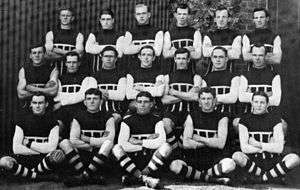
Bottom: Port Adelaide's undefeated 1914 SAFL premiers and Champions of Australia team.
In 1902, Port Adelaide took the field in black and white guernseys for the first time after it was having trouble finding dyes that would last for its blue and magenta guernseys.[19] The first year in the new guernsey would be a controversial year for the club. After finishing the 1902 season on top of the ladder, Port Adelaide was disqualified from a game with South Adelaide after disputing the use of an unaccredited umpire.[20] The 1902 SAFA premiership would subsequently be awarded to North Adelaide after they defeated South Adelaide in the Grand Final a week later.[21] Port Adelaide offered to play North Adelaide in a premiership deciding match, but the association refused.[22] The first premiership after the dispute came the following year when Port Adelaide defeated South Adelaide 6.6 (42) to 5.5 (35) in the 1903 SAFA Challenge Final. In 1906 Port Adelaide appointed James Hodge as club secretary. Hodge would quickly earn the nickname 'Columbus' after taking the club on trips to play exhibition games all across Australia.[23] That year would also see further premiership when Port defeated North Adelaide 8.12 (60) to 5.9 (39) in the year's Grand Final. During the early stages of the 1907 season, Port Adelaide travelled to Sydney to play a combination of the cities best players. The game was marketed as 'Port Adelaide vs. Sydney' with the harbour city side taking the honours 8.9 (57) to 5.14 (44).[24]
| 1910 Championship of Australia | G | B | Total |
| Port Adelaide | 15 | 20 | 110 |
| Collingwood | 7 | 9 | 51 |
| Venue: Adelaide Oval | |||
| 1910 Port Adelaide vs. WAFL[25] | G | B | Total |
| WAFL | 6 | 12 | 48 |
| Port Adelaide | 6 | 17 | 53 |
| Venue: Fremantle Oval | |||
Port Adelaide won the SAFL premiership in 1910 defeating Sturt 8.12 (60) to 5.11 (41) in the Grand Final. The club would go on to defeat Collingwood for the 1910 Championship of Australia title. During the 1910 post season, seeking revenge for their loss the year before, Port Adelaide travelled to Western Australia and beat East Fremantle by 12 points. To conclude the trip Port Adelaide played a combination of some of the WAFL's best players and achieved a remarkable victory scoring 6.17 (53) to 6.12 (48), with Sampson Hosking named best on ground.[26] Along with beating the premiers from South Australia, Victoria and Western Australia in 1910, Port Adelaide also invited North Broken Hill, the premier team of New South Wales, to a game at Adelaide Oval. Port Would win this game 14.20 (104) to 5.5 (35).[27]
The following two seasons for Port Adelaide would be frustrating dropping only one game during the 1911 minor round and going undefeated the following year in 1912 only to be knocked out of contention by West Adelaide both times, the second of these encounters in front of a pre war South Australian record crowd of 28,500. During the 1912 preseason, Port Adelaide travelled to Tasmania and took on a combination of players from various Tasmanian Football League (TFL) sides. The game would prove to be very competitive with Port Adelaide defeating the TFL combination 7.13 (55) to 6.6 (42).[28]
| 1913 Championship of Australia | G | B | Total |
| Port Adelaide | 13 | 16 | 94 |
| Fitzroy | 4 | 7 | 31 |
| Venue: Adelaide Oval | |||
During the 1913 preseason, Port Adelaide travelled back to Western Australia to play East Fremantle again with the local side winning for a second time 6.6 (42) to 4.12 (36). Despite this inauspicious preseason the club would break through in 1913, dropping only two games during the minor round and eventually defeating North Adelaide 7.12 (54) to 5.10 (40) for the SAFL premiership and Fitzroy 13.16 (94) to 4.7 (31) for the 1913 Championship of Australia.
| Port Adelaide v South Australia | G | B | Total |
| South Australia | 5 | 10 | 40 |
| Port Adelaide | 14 | 14 | 98 |
| Venue: Jubilee Oval | |||
| 1914 Championship of Australia | G | B | Total |
| Port Adelaide | 9 | 16 | 70 |
| Carlton | 5 | 6 | 36 |
| Venue: Adelaide Oval | |||
The 1914 Port Adelaide Football Club season is widely regarded as one of the best in Australian rules football history. It won all its pre season matches, won all fourteen SAFL games by an average margin of 49 points and the 1914 SAFL Grand Final where it held North Adelaide to a single goal for the match 13.15 (93) to 1.8 (14). The club would then meet VFL premiers Carlton on Adelaide Oval, defeating the Victorian club by 34 points to claim a record fourth Championship of Australia. At the end of the 1914 season, a combined team from the six other SAFL clubs played Port Adelaide and lost to the subsequently dubbed "Invincibles" by 58 points.[29] Key players from this era were Harold Oliver, Angelo Congear and Sampson Hosking who all share the unique distinction of playing in three Championships of Australia together as well all taking part in South Australia's first victorious Australian National Football Carnival in 1911.[30]
1919–1949: Two World Wars and the Great Depression
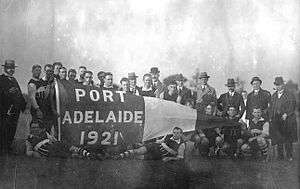
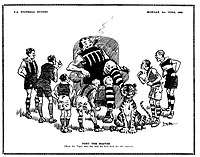
Right: Cartoon from the South Australian Football Budget after Port Adelaide's start to the 1928 SANFL season.
During World War I the club lost three players—William Boon, Joseph Watson and Albert Chaplin—to the war. A scaled-back competition referred to as the 'Patriotic League' was organised during wartime in which Port Adelaide won the 1916 and 1917 instalments.
After World War I, Harold Oliver, arguably the state's best player, was close to retiring from league football playing only 1 game in 1919 and 8 in 1920. However keen supporters of the club hoping to replicate its pre-war success raised funds and bought him a motorbike so he could commute from his farm in Berri for the 1921 season.[32] Oliver would captain the club to the 1921 premiership, winning his fourth in the process. In 1922 after playing only 5 league matches for the season his football career came to an end due to commitments regarding his farm and disputes regarding game compensation. His contract termination meant he was paid £76 of £100 pounds for the season making him one of the highest-paid footballers of the era.[33] At the end of the 1922 SAFA season, Port Adelaide travelled to Sydney and played a combined New South Wales side on the Sydney Cricket Ground winning the match.[34] In following seasons most of Port Adelaide's champion players from before the war started to retire and the club's performances declined.[35]
.jpg)
%2C_May_1945.jpg)
Right: Haydn Bunton Sr joined Port Adelaide for the 1945 season forming a formidable ruck trio with Bob Quinn and Bob McLean.
| 1939 SANFL Grand Final | G | B | Total | |||
| Port Adelaide | 16 | 28 | 124 | |||
| West Torrens | 11 | 11 | 77 | |||
| Venue: Adelaide Oval | crowd: 44,885 | |||||
As was the case in the 1890s, the depression of the early 1930s hit the club hard with players moving interstate to secure employment.[35] By the late 1930s, the economy and Port Adelaide's form both recovered and after two narrow grand final losses in 1934 and 1935 the club won premierships in 1936, 1937 and 1939. During 1939, Bob Quinn, in his third year as a player for the club, coached the team to a Grand Final win over West Torrens. Many Port Adelaide players also enlisted for military service during this time.[36] In 1941 Port Adelaide suffered its first player casualties from war since World War I with Lloyd Rudd and Jack Wade both killed on the Allies' front in France. Four more players would be killed through the war: Maxwell Carmichael, George Quinn, Christopher Johnston and Halcombe Brock.[37][38]
| 1942 Wartime fundraiser | G | B | Total | |||
| Port Adelaide/West Torrens | 20 | 23 | 113 | |||
| "The Rest" | 20 | 21 | 111 | |||
| Venue: Adelaide Oval | [39] | |||||
Just as had happened in 1914, the league was being hit hard by player losses in World War II. Due to a lack of able men the league's eight teams were reduced to four with Port Adelaide merging with nearby West Torrens from 1942 to 1944. The joint club would play in all three Grand Finals during this period, winning the 1942 instalment but losing the 1943 and 1944 editions to the Norwood-North Adelaide combination. Normal competition resumed in 1945. After finishing his military service Haydn Bunton Sr., now a triple Brownlow and Sandover medallist, joined the club for his final season.[40] However, despite this addition Port Adelaide was unable to regain its pre-war success with West Torrens mounting a remarkable comeback to win the 1945 SANFL Grand Final in what was the only one Bunton's career. The first ever 'All-Australian' side concept was created by Sporting Life magazine in 1947 with Bob Quinn named the sides captain.
1950–1973: Fos Williams era and Jack Oatey rivalry
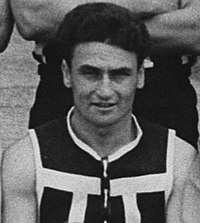
At the end of the 1949, having missed two finals series in a row, the Port Adelaide Football Club had become desperate to improve its on-field performances. The club's committee subsequently sought out a coach that could win the club its next premiership.
Eventually a decision was made which would influence the next 50 years of the Port Adelaide Football Club with Foster Neil Williams, a brilliant rover from West Adelaide, being appointed captain-coach of the club. Williams brought to the club a new coaching style based on success at any cost which was succinctly encapsulated in the legendary club creed he eventually wrote in 1962. During his second season as coach in 1951, Williams led Port to their first official premiership (excluding World War II competition) for 9 seasons, defeating North Adelaide by 11 points. At the end of the 1951 season the VFL premiers Geelong visited South Australia to play the local premiers Port Adelaide on Adelaide Oval. Geelong won the match 8.14 (62) to 6.18 (54) in front of 25,000 people.[41] Port Adelaide would make the Grand Final again in 1953 against local rivals West Torrens in what would be the Eagles last appearance before merging with Woodville. West Torrens would disappoint Port Adelaide, winning the 1953 premiership by 7 points.
| 1957 SANFL Grand Final | G | B | Total |
| Port Adelaide | 15 | 15 | 105 |
| Norwood | 13 | 16 | 94 |
| Venue: Adelaide Oval | Crowd: 58,924 | ||
Port Adelaide's run of disappointment from the 1952 and 1953 seasons would prove to be short lived with the club subsequently going on to win a national record six Grand Finals in a row from 1954 to 1959. The club had a win-loss-draw record of 105–16–1 (86%) over the six-year period. During the 1950s Port Adelaide and Melbourne, often the premiers of South Australian and Victorian leagues, played exhibition matches at Norwood Oval. The most notable game was the 1955 match with an estimated crowd of 23,000. The game being a thriller going down to the last 15 seconds with Frank Adams kicking a behind and sealing the game 9.11 (65) to 9.10 (64) in favour of Norm Smith's demons.[42][43] The following year Melbourne was full of praise for their cross border challenger with those in the Demons camp agreeing that "Port Adelaide could take their place in the V.F.L. competition and do themselves credit".[44]
Geof Motley took over the captain-coaching role at the club in 1959 when Williams left to take a break from the game. That year the club won the premiership setting a national record of sixth consecutive Grand Final victories. Port Adelaide's hope of winning 7 consecutive premierships was brought to an end in the 1960 preliminary final when Norwood won by 27 points. For the following two seasons Port Adelaide would finish third.
| 1965 SANFL Grand Final Fos Williams ninth premiership. | G | B | Total | |||
| Port Adelaide | 12 | 8 | 80 | |||
| Sturt | 12 | 5 | 77 | |||
| Venue: Adelaide Oval | Crowd: 62,543[45] | |||||
Fos Williams returned in 1962 and Port Adelaide won three of the next four premierships taking his personal tally to nine and the club's record to 10 of the last 15 premierships. At the end of 1962 the Woodville Football Club, based in a neighbouring suburb to Alberton, was admitted to the SANFL in an attempt to weaken Port Adelaide via taking up some of its suburban recruiting zone. In 1965, Fos Williams coached his last premiership in-front of 62,543 people, the largest ever crowd at Adelaide Oval. In that game Port Adelaide defeat Sturt by 3 points. After the 1965 Grand Final, Port Adelaide would be frustrated by the dominance of Sturt, which won seven premierships over this period under the leadership of Jack Oatey. In all, despite playing in 6 of the next 10 grand finals, Port Adelaide would fail to win a premiership until 1977.
1974–1998: John Cahill, SANFL domination and AFL entry

One of Port Adelaide's finest players during the Fos Williams era was John Cahill. He eventually became William's protégé and ultimately took over as coach in 1974. In 1975 a dispute between the Port Adelaide City Council and the SANFL over the use of Alberton Oval forced Port Adelaide to move its home matches to Adelaide Oval for two seasons. In 1976 Cahill would subsequently take Port Adelaide to its first Grand Final under his leadership against Sturt with an official attendance of 66,897, the record for football in South Australia. The actual crowd was estimated at 80,000, much bigger than the official figure as Football Park ran out of tickets early and were forced to shut the gates 90 minutes before the bounce as people were being crushed on entry.[46] Sturt won in an upset by 41 points.
In 1977 the dispute regarding Alberton Oval was resolved and the club moved back to its home ground and won that years premiership breaking an 11-year drought which at the time was Port Adelaide longest since competing in an organised football competition.
| 1977 SANFL Grand Final | G | B | Total | |||
| Port Adelaide | 17 | 11 | 113 | |||
| Glenelg | 16 | 9 | 105 | |||
| Venue: Football Park | Crowd: 56,717[47] | |||||
"It has taken us a bloody long time but by gee it was worth it!"
The 1980 season was Port Adelaide's most dominant since 1914. All SANFL divisions of the club made finals with both the league and reserve sides winning their respective premierships. Russell Ebert won his record 4th Magarey Medal. Tim Evans set the then-league goal kicking record of 146 goals in a season. The club provided seven players to the state league team (Ebert, Evans, Cunningham, Phillips, Williams, Giles and Faletic). The club set a new record for most points scored during the whole season at 3,421 whilst also having the best defence conceding only 1,851 points. Overall Port Adelaide lost 2 games from 24 for the year.
Russell Ebert became coach in 1983 when Cahill left to coach Collingwood for two seasons. This period saw the club fail to reach the grand final. The period also marked the rise of the VFL as Australia's premier football competition. Many SANFL players were moving to the VFL larger salaries. In 1982 the SANFL, Norwood and East Perth all approached the VFL in regards to entering the league. All were ignored at the time.[49] Port Adelaide's report from 1982 showed that the failure of these attempts impacted the understanding of its future.[50] From this point onwards the club restructured in regards to economics, public relations and on-field performance for an attempt to enter the league. There was genuine feeling that failure to do this would result in the club ceasing to exist in the future.[49] Talk of a side from South Australia entering the VFL was fast tracked in 1987 when a team from Western Australia, the West Coast Eagles, and a team from Brisbane, the Brisbane Bears joined the VFL. South Australia was left out as the only mainland state without a team.
John Cahill returned as coach for the 1988 season. During that year, one of Fos Williams sons, Anthony, was tragically killed in a building accident. The following day the club played against Norwood and managed to overcome an early deficit to win the emotionally charged game. The club would go on to win the 1988 premiership.
In 1989 seven out of ten SANFL clubs were recording losses and the combined income of the SANFL and WAFL had dropped to 40% of that of the VFL.[51] During early 1990 the SANFL decided to wait three years before making any further decision in regards to fielding a South Australian side in the VFL until it could be done without negatively affecting football within the state. Frustrated with lack of progress, Port Adelaide were having secret negotiations in the town of Quorn for entry in 1991.[52] From these discussions Port Adelaide Football Club accepted an invitation from the VFL to join what had now become the AFL. The AFL signed a Heads of Agreement with the club in expectation that Port would enter the competition in 1991, meaning the Port Adelaide Football Club would field two teams, one in the AFL and one in the SANFL. During the 1990 preseason Port Adelaide played a practice match against the Geelong at Football Park in front of 35,000 spectators with Gary Ablett Snr and Gavin Wanganeen prominent.
| 1990 SANFL Grand Final Last season without AFL in SA. | G | B | Total | |||
| Glenelg | 13 | 15 | 93 | |||
| Port Adelaide | 16 | 12 | 108 | |||
| Venue: Football Park | Crowd: 50,589[53] | |||||
When knowledge of Port Adelaide's negotiations to gain an AFL licence were made public, many in the SANFL saw it as an act of treachery. SANFL clubs urged Justice Olssen to make an injunction against the bid, which he agreed to.[54] The AFL suggested to the SANFL that if they didn't want Port Adelaide to join the AFL, they could put forward a counter bid to enter a composite South Australian side into the AFL. After legal action from all parties, the AFL finally agreed to accept the SANFL's bid and the Adelaide Football Club was born.[55]
"These twenty blokes, everyone whose helped us, are sensational people and all the views that you have read in the press the one thing that really matters is that there will always be a Port Adelaide Football Club."
— George Fiacchi upon accepting the 1990 Jack Oatey Medal for best on ground at the 1990 SANFL Grand Final.[56]
During December 1994 Max Basher announced that Port Adelaide had won the tender for the second South Australian AFL licence.[57] However a licence did not guarantee entry and although a target year of 1996 was set, this was reliant upon an existing AFL club folding or merging with another. In 1996, the cash-strapped Fitzroy announced it would merge with the Brisbane Bears to form the Brisbane Lions. A spot had finally opened and it was announced that in 1997, one year later than expected, Port Adelaide would enter the AFL.
Once an entry date had been confirmed, the Port Adelaide Football Club set about forming a side fit for competition in the AFL. It was announced that existing Port Adelaide coach, John Cahill would make the transition to the AFL and Stephen Williams would take over the SANFL coaching role. Cahill then set about forming a group which would form the inaugural squad. Brownlow Medallist and 1990 Port Adelaide premiership player, Gavin Wanganeen was poached from Essendon and made captain of a team made up of six existing Port Adelaide players, two from the Adelaide Crows, seven players from other SANFL clubs and 14 recruits from interstate. Of the 35 players on Port Adelaide's inaugural AFL list 13 had played for the club before. The AFL's father son rule for the club was set at 200 games for players before 1997. This compared to only 100 for Victorian clubs.
| 1997 West End Showdown I | G | B | Total | |||
| Adelaide Crows | 11 | 6 | 72 | |||
| Port Adelaide | 11 | 17 | 83 | |||
| Venue: Football Park | Crowd: 47,265 | |||||
On 29 March 1997, Port Adelaide played its first AFL premiership match against Collingwood at the MCG, suffering a 79-point defeat. Port won its first AFL game in round 3 against Geelong, and defeated cross town rivals and eventual premiers Adelaide by 11 points in the first Showdown in round 4. At the conclusion of round 17, the side sat fifth – only one win and percentage off the top spot in what was an unusually close season – but it fell out of the finals after recording only a draw from its final five games. Port Adelaide finished its first season 9th, missing the finals on percentage behind Brisbane. The 1998 season was looking very similar to the previous year as they hovered around ninth position for most of the year and looked like a threat for finals after round 14; but they lost six of their last eight games to finish in 10th place, with a record of 9 wins, 12 losses and 1 draw.
1999–2012: Mark Williams, inaugural AFL premiership and Primus period
In 1999 Mark Williams took over as coach of Port Adelaide. They earned a spot in the AFL finals for the first time. They were eliminated by eventual premier, North Melbourne, by 44 points in the Qualifying Final. After finishing 14th in 2000, Port Adelaide had a very successful 2001 season, starting with a maiden pre-season competition victory, defeating the Brisbane Lions. Port Adelaide finished their 2001 home and away season in third place with 16 wins and six losses. The club travelled to Brisbane for the Qualifying Final, losing by 32 points, then lost its home Semi-final against sixth-placed Hawthorn to be eliminated. Port Adelaide started 2002 strongly, winning the pre-season competition for the second time in a row, defeating Richmond by 9 points. The side built on its success and won its first AFL minor premiership with an 18–4 record. However, they lost to the eventual premiers, the Brisbane Lions, by 56 points in the preliminary final. Port Adelaide continued its minor round dominance in 2003 and again finished top to claim the minor premiership; however like the previous year, Port Adelaide was eliminated in the preliminary final, losing to Collingwood by 44 points.
Port Adelaide opened the 2004 season well with four straight wins, but then won only four of its next eight games. From rounds 12–17, Port Adelaide turned their fortunes around and had six consecutive wins, and with five rounds remaining were equal top of the ladder with Brisbane, St Kilda and Melbourne. After losing in round 18 to Essendon, Port Adelaide won its remaining four games – including wins against minor premiership contender Melbourne and cross town rivals Adelaide to claim the minor premiership for the third consecutive year. Port Adelaide easily won its qualifying final against Geelong, earning a home preliminary final. Port Adelaide made it through to its first AFL grand final after defeating St Kilda in a thrilling preliminary final by just six points with Gavin Wanganeen kicking the winning goal with a minute to go.
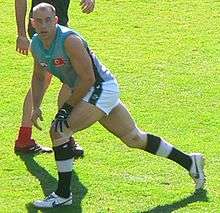
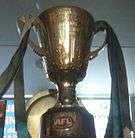
Right: The 2004 AFL premiership was Port Adelaide's first since joining the league.
The following week Port Adelaide faced a highly fancied Brisbane side attempting to win a record-equalling fourth straight AFL premiership. Only one point separated the sides at half time, however late in the third quarter Port Adelaide took the ascendency to lead by 17 points at three-quarter time, and dominated the final term to win by 40 points: 17.11 (113) to 10.13 (73). Byron Pickett was awarded with the Norm Smith Medal after being judged the best player in the match, tallying 20 disposals and kicking three goals.
| 2004 AFL Grand Final | G | B | Total | |||
| Port Adelaide | 17 | 11 | 113 | |||
| Brisbane Lions | 10 | 13 | 73 | |||
| Venue: Melbourne Cricket Ground | Crowd: 77,671 | |||||
"Port Adelaide are the winningest team in Australia. The ol' Port Adelaide have won 36 premierships, today, at the MCG, may just be their finest hour."
After a slow start to the 2005 season, Port finished eighth on the ladder, and defeated the Kangaroos by 87 points in the elimination final. In the semi-final, Port faced minor premiers Adelaide and lost by 83 points. After missing the finals in 2006 Port Adelaide made a strong recovery in 2007, and with strong performances from midfielders Shaun Burgoyne and Chad Cornes and strong debut seasons from Justin Westhoff, Robert Gray and Travis Boak, Port Adelaide finished the minor round second on the ladder with 15–7 record. Port Adelaide started their finals campaign against the West Coast Eagles at Football Park and won by three points. That win gave Port the bye, and they easily defeated the Kangaroos in the preliminary final to win by 87 points. This win delivered Port its second Grand Final berth in four years. However, in the grand final they were defeated by Geelong by an AFL record margin of 119 points, 24.19 (163) to Port Adelaide's 6.8 (44) in a crowd of 97,302.
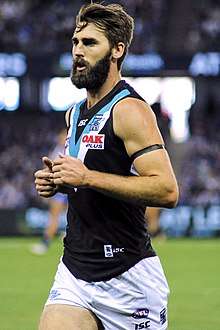
The 2008 season was disappointing one for a Port Adelaide side keen to build on its 2007 grand final appearance, dropping to 13th on the ladder and out of the finals. By 2009 Port Adelaide had accumulated a consolidated debt totaling $5.1 million and was unable to pay its players; they had lost $1.4 million the season before. Financial assistance was denied by the league, with AFL Chief Executive Andrew Demetriou saying that they would have to undergo an intensive application process and work with the SANFL, who owned Port Adelaide's AFL licence.[59] On 20 May, Port were handed $2.5 million in debt relief by the SANFL, and on 15 June were handed a $1 million grant by the AFL commission.[60][61] The SANFL had announced it would not support Port Adelaide in both the AFL and SANFL. Plans for a re-merging the two teams was rejected by the SANFL. Amidst these off-field struggles, the club finished 10th in 2009. The 2010 season would see Mark Williams step down as senior coach marking the end of the Williams era for the club.
"He (Demetriou) said he could not imagine an AFL competition without Port Adelaide in it. I thought that was a really strong statement of leadership."
Matthew Primus took over as caretaker coach for Port Adelaide after Mark Williams stood down.[63] The club finished the 2010 season with five wins from its last seven games to finish tenth. On 9 September, Matthew Primus was appointed as the senior coach of the club for the next three years. The SANFL sought to take control of Port Adelaide in 2011. Despite underwriting $5 million of Port's debt in 2010, the takeover failed when the SANFL was unable to get a line of credit to cover Port Adelaide's future debts. The AFL announced it would underwrite $1.25 million in debt to protect its $1.25 billion television rights. AFL Chief executive Andrew Demetriou, offered $9 million over the next three years to help the club, ahead of the move to the Adelaide Oval. The AFL gave the money to the SANFL with strict conditions that they give Port Adelaide three million dollars a year, for three years.[64] Statistically, 2011 was Port Adelaide's worst season in 141 years, finishing 16th with only three wins from 22 games. Rounds 20 and 21 saw the club lose to Collingwood and Hawthorn by record margins of 138 and 165 respectively. The 2012 season was marginally better but a loss against Greater Western Sydney resulted in senior coach Matthew Primus stepping down. Assistant coach, Garry Hocking, took over for the remaining four games, with a draw in the final round against Richmond the best result.
2013–present: Ken Hinkley, Adelaide Oval return and independence
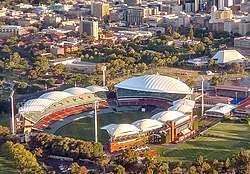
On 8 October 2012, Ken Hinkley was announced as the new senior coach of the club. This marked the first time that the club had appointed someone not associated with the club before since Fos Williams in 1950. Television personality David Koch was named chairman of the club and numerous board members were replaced. The 2013 preseason also saw Travis Boak succeed Domenic Cassisi as captain of the club.[65] The club finished the home and away season 7th on the ladder, making it the first time that they had qualified for the finals since 2007. Port travelled to Melbourne to play Collingwood at the MCG in an Elimination Final where they won by 24 points; they then lost to Geelong by 16 points the following week in a Semi-final.
The 2014 season saw both Port Adelaide and Adelaide move their home ground from Football Park to the redeveloped Adelaide Oval. Port Adelaide signed up a record 55,715 members for the 2014 season and averaged 44,429 at home games, a 65% increase from the previous year. Port Adelaide had its best first half of an AFL season, sitting first with ten wins from eleven matches. They then won only four of their remaining eleven matches to finish fifth on the ladder. They hosted Richmond in the elimination finals, kicking the first seven goals of the game and leading by as much as 87 points before recording a 57-point victory. After defeating Fremantle in the semi-finals the club's 2014 season ended with a three-point loss to Hawthorn in the preliminary finals.
With great expectation, Port Adelaide started the 2015 season playing all of the year's finalists in the opening 10 rounds and entered the mid-season break with a 5–7 record. The club had a better second half of the year, recording 7–3, but would miss out on finals by one win. The club did not fare any better in 2016, winning only ten matches and finishing 10th. In 2017, Port Adelaide had made a massive improvement from the previous 2 seasons, winning 14 of 22 games to finish 5th on the ladder. Port Adelaide's season came to an end in an elimination final loss to West Coast by 2 points in extra time. The club would again narrowly miss the finals in 2018 and 2019, finishing 10th in both seasons.
Club symbols and identity
Wharf Pylon / "Prison Bar" guernsey


Right: Clifford Cocks wearing the first Port Adelaide guernsey with the number panel attached to the back for a trip to Western Australia in 1910.[67]
The Port Adelaide Football Club adopted the black and white Wharf Pylon / "Prison Bar" guernsey after having difficulty finding magenta and blue dyes that would repeatedly last the rigours of an Australian rules football match. Prior to adopting the Wharf Pylon / "Prison Bar" guernsey the club won 3 premierships over 31 years. After adopting the Wharf Pylon / "Prison Bar" guernsey in 1902 the club would, in controversial circumstances, be disqualified from finals but after would ultimately win 31 premierships and 3 Championships of Australia in the black and white guernsey before being admitted into the AFL in 1997.
"Anyone that put on the guernsey acted like the guernsey intended it to act. It wasn't built around the player wearing the guernsey. It was the guernsey using a player."
— Retired Port Adelaide player and coach Fos Williams explaining the mythology of the guernsey in 1981., [68]
Nickname origin
The "Prison Bar" nickname originated from fans of the Norwood Football Club in the late 1980s and early 1990s in an attempt of deriding the Port Adelaide supporter base, playing on Port Adelaide's strong working class demographic. Supporters of Port Adelaide quickly adopted this insult as their own for the name of the guernsey. The 'Prison Bar' name eventually becoming part of the mystique and intimidation of the guernsey.
"Prison bars" has become a recent phenomenon, seemingly pushed – quite successfully – by those determined to cast the Port Adelaide image as an unsavoury part of society. Still, if it generates an image of fear, this will be taken as a compliment at Alberton.
— Michelangelo Rucci., The Advertiser (Adelaide), 2014.[69]
Number panel
The number panel on the back of the Port Adelaide guernsey originates from the first decade of the twentieth century when club secretary James Hodge took the club across Australia to play matches against interstate teams[23] During Hodge's time as secretary the club played exhibition matches in Kalgoorlie, Perth, Fremantle, Hobart, Devonport, Melbourne, Bendigo, Ballarat, Sydney, Albury, Wagga Wagga and Broken Hill. As spectators from other states were unfamiliar with the majority of Port Adelaide's players the club attached white squares with black numbers to the reverse of their guernseys and assigned numbers alphabetically so that spectators could identify players on the field with the team lists from newspapers covering the match.
Captain and No. 1 guernsey
The tradition dictating that the captain of the Port Adelaide Football Club wear the number one guernsey started when Clifford Keal wore the number as club captain for the first time in 1924. The tradition was cemented, at least in the eyes of then-secretary Charles Hayter, when in 1929 he received a letter from a junior Kilkenny player requesting a number one Port Adelaide guernsey as he had just become captain of his underage team.[70] Charles Hayter granted the wish of the junior and provided him with a number one Port Adelaide guernsey.[70] There have been exceptions to this tradition since 1924, often involving club captains being injured, however in almost all instances since 1924 the club captain has worn the number one guernsey. The most notable exception to this rule was when Geof Motley followed the captaincy of Fos Williams. Motley wore the number one guernsey in his first game as club captain but the pressure of following in Fos Williams footsteps, who just lead the club to five consecutive premierships, was too much and he requested that he revert to the number 17 for the remainder of his career. When Motley handed the captaincy to John Cahill in 1967, at the insistence of coach Fos Williams, the tradition of Port Adelaide captains wearing the number one guernsey resumed. When co-captains were appointed for the 2019 season the No. 1 guernsey was temporarily retired.
Wharf pylon design
The guernsey was designed to be a literal depiction of the wharves and pylons that were prominent along the docks of Port Adelaide at the turn of the 20th century.

Wharf Pylon / "Prison Bars" in the AFL
Upon joining the AFL, Port Adelaide, along with being required to find a new logo, song and nickname, was also forced to replace the Prison Bar guernsey because existing club Collingwood, already using the Magpie logo and nickname, also wore a guernsey with vertical black and white stripes.[71] In 1995, a new guernsey was created incorporating teal.
In May 2007, chief executive John James stated that Port Adelaide received more correspondence from its supporters about the heritage guernsey than all other issues and that the club would "fight for its heritage and what is right". Port Adelaide decided not to participate in the 2006 heritage round when the AFL declined the club's 1980s guernsey for its 80s-themed heritage round.[72]
In 2007, the club was waiting for confirmation from the AFL that it could wear its 1970s' "Prison Bar" guernsey for a match against the Western Bulldogs, and wanted confirmation it would be able do so in any future heritage rounds. On 14 May 2007, the AFL and Port Adelaide reached an agreement whereby the club could wear its traditional guernsey in the heritage round, with the proviso that in future seasons its players can only wear it in home heritage round games and provided that such a game is not against Collingwood.[73] No heritage rounds have been held since this agreement was reached.
"This team from South Australia – this Port Power (sic) – why would they pick black and white? Did the competition really need another club in navy or dark colours?".
— Collingwood Football Club president Eddie McGuire's 2003 statement regarding Port Adelaide wearing its traditional guernsey., [74]
"He's a Port Adelaide boy born and bred Warren Tredrea and over a hundred years of magnificent history in this jumper is what foaled the Port Adelaide AFL team and they've done their heritage proud today".
— AFL commentator Dwayne Russell at the conclusion of the 2003 Heritage Round between Port Adelaide and Carlton., [75]
Collingwood club president Eddie McGuire has been a vocal opponent of Port Adelaide wearing the "Prison Bar" guernsey, claiming that Collingwood has an exclusive right to wear black and white in the AFL, even in the heritage round.
"It should have nothing to do with Eddie McGuire and Collingwood ... I'll say that for a start."
— Leigh Matthews during a discussion regarding Port Adelaide's traditional guernsey during the 2014 Elimination Final., [76]
Support for the guernsey remains extremely high, with a limited batch of jumpers for a game against Carlton in 2013 resulting in an increase to the club's revenue of around $1,000,000, according to club CEO Keith Thomas. In 2014 the AFL declined Port Adelaide permission to wear its traditional guernsey for celebrating of 100 years since its 1914 Championship of Australia.[77] There was controversy in 2014 during the lead-up to the final against Richmond when the AFL told Port Adelaide they had to wear their clash guernsey. On 2 September 2014 the AFL cleared them to use the traditional guernsey for the match.
"I've always regarded that strip that Port are wearing today as the best uniform in Australian Football".
— Dennis Cometti describing Port Adelaide's traditional guernsey during the 2014 Elimination Final., [78]
"If they wore it the whole year and not against Collingwood I got no worries. It's a different jumper...I don't think it should be Eddie's say; the AFL, they run the competition".
Towards the end of 2018, a group of supporters organised to push for the return of the club's traditional guernsey full time from the start of the 2020 AFL season to coincide with the club's 150th anniversary year.[80] Prominent football commentators who have given support to the campaign to reinstate the guernsey include Tony Shaw,[81] Paul Hasleby,[82] Mark Bickley,[83] Dale Lewis[84] along with current Port Adelaide players Travis Boak,[85] Robbie Gray[86] and Ollie Wines.[87] Former South Australian premier Jay Weatherill has also given support to the push to reinstate the guernsey.[88] A supporter petition calling for the reinstatement of the guernsey reached 10,000 signatures.[89] The club was granted permission to wear the guernsey in their two Showdown matches in the 2020 season.[90] On 30 August 2019 Port Adelaide's CEO Keith Thomas stated that there was no agreement in place to prevent the club wearing the guernsey again beyond 2020.[91] On 1 June 2020 Port Adelaide's Chairman David Koch stated that he would like to see the club wear the guernsey for the Showdown in 2020 along with 2021.[92] On 3 June 2020 Eddie McGuire said that David Koch "doesn't have the guts to tell his supporters that it's finished!".[93] The following day on 4 June 2020, David Koch submitted an application on behalf of Port Adelaide for the club to wear the guernsey in all Showdown's going forward arguing that "There is an existing agreement in place from 2007 between Port Adelaide, Collingwood and the AFL that states clearly Port Adelaide has permission to wear the black-and-white Prison Bar guernsey in all home AFL Heritage Rounds thereafter. Ironically, Heritage Rounds ceased to exist from that point. We will argue that Showdowns now represent the heritage of South Australian football and we should therefore be granted permission to wear it on an ongoing basis...In a year like no other when we’ve seen the importance of family, community and heritage we believe any decision not to allow us to wear this guernsey in Showdowns would be nothing short of mean spirited...One of the charters of the AFL is to protect and celebrate the heritage of our great game. We think wearing our black-and-white Prison Bar guernsey in Showdowns does just that."[94] The same night on the 4 June 2020 current Collingwood coach Nathan Buckley came out in support of Port Adelaide's request to wear it's Prison Bar guernsey in Showdowns.[95] On 11 June 2020 current South Australian premier Steven Marshall (joining his predecessor Jay Weatherill[88]) in providing his support to the push for the guernsey to be worn in Showdown's every year.
Uniform evolution
- Notes
- The recorded colours worn by the club.
- Original full magenta uniform.
- Better dyes resulted in magenta appearing closer to red. Blue bib added to top of uniform.
- Magenta and blue stripes with leather lace divider.
- Wharf Pylons / "Prison Bars" uniform. Worn for all South Australian premierships since 1902 except for 1951. Used in the 2003, 2007, 2013, 2014 and 2020 AFL seasons.
- Inaugural uniform in the AFL. Port Adelaide was required to incorporate teal and remove horizontal stripes by the AFL to appease Collingwood.
- Permanently used in the AFL since 2010.
Club songs
Over the years Port Adelaide has used various songs and music at its games. In its first season during 1870 the club invited local brass bands to play during the club's first games at Glanville.[96]
"Work, Boys, Work" (1880s)
In 1882 a song based on Harry Clifton's "Work, Boys, Work (and be contented)" was written for the club as a tribute to the recently retired player Thomas Smith.[97]
"Pride of Port Adelaide" (1921–1970)
From around the end of World War I until 1970 the club song was "The pride of Port Adelaide is my football team".[98]
"Cheer, Cheer the Black and the White" (1971–1996, SANFL)
In 1971, Port Adelaide secretary Bob McLean decided to change the club song to "Cheer, Cheer the Black and the White" after hearing the South Melbourne Football Club's song based on the Notre Dame Fighting Irish football team's "Victory March".[99] As the Sydney Swans were already using the Notre Dame Victory March when Port entered the AFL, the club was forced to find a new song. Cheer, Cheer the Black and the White is still used for Port Adelaide's reserves in the SANFL.
"Power To Win" (1997–present)
Upon joining the AFL and requiring a new song, Port Adelaide eventually chose the "Power to Win" which was written for the club by Quentin Eyers and Les Kaczmarek. The song was first played at AFL level after Port's win against Geelong in round 3, 1997 at Football Park.[100] Since 2016, an alternative Pitjantjatjara language version of the song ('Nganana wanangara kanyini' – literally, 'We have the lightning bolt') has been used by the club on occasions such as Indigenous Round. Because the club is not officially known as 'Port Power' but just 'The Power', the line in the song "..til the flag is ours for the taking, Port Power!" was eventually changed, deleting the word 'Port' and the song was re-recorded. This change is also reflected when the team sings the song at the end of a game.[101]
"Never Tear Us Apart" (2014–present)
Since March 2014, Port Adelaide has used "Never Tear Us Apart" by the Australian band INXS as the club's unofficial anthem leading up to the opening bounce at its new home of Adelaide Oval. The song is used as a reference to the various and unique difficulties the club faced when trying to enter the AFL.
Port Adelaide's use of the song stemmed from a trip the club took to Anfield in November 2012 while they were in England to play an exhibition match against the Western Bulldogs.[102] In light of the very positive reviews given by the club's players towards the Anfield crowd's rendition of "You'll Never Walk Alone", Matthew Richardson, Port's general manager of marketing and consumer business, along with the club's management, sought to replicate the pre-match experience they experienced at Anfield. At a meeting in mid-2013, the idea of an anthem was raised; a number of various songs were suggested, including "Power and the Passion" by Midnight Oil and "Power to the People" by John Schumann. Eventually, "Never Tear Us Apart" by INXS was suggested by Port Adelaide's events manager, Tara MacLeod. It was eventually accepted, due to the fact that the song resonated with the club's history.[102] In particular when Port Adelaide's was forced to separate its AFL and SANFL operations forcing its local side to train at Ethelton to ensure they would not gain an advantage using the Alberton training facilities.[103] Australian football historian John Devaney described the forced separation of Port Adelaide's SANFL and AFL operations as being "akin to the enforced splitting up of families associated with military conquest or warfare".[104]
Initially the song was introduced to coincide with the 60-second countdown before the start of a match, with the music playing over the top of a video montage. The song proved to be a success among the fans, with them adopting the song as well as raising scarves above their heads as the song was being sung.[102] So successful was the song that by June 2014, the club were forced to print club coloured scarves with the words "Never Tear Us Apart" on them that fans would hold aloft and sing in unison prior to the start of matches.
Logo evolution

Port Adelaide has adopted different insignia's on several occasions throughout its history. The original club crest, adopted in 1900, featured a tan football and magpies perched on a gum tree with a black and white striped flag on the left and the Australian Red Ensign on the right.[105] The ensign switched to blue sporadically through the 1910s before the flags were dropped in 1928. From 1930 to 1996, the logo always featured a dexter (left-facing) magpie perched upon a gum branch (1930 to 1953) and a fence wire (1954 to 1974). The last Magpies-specific logo, used by the club from 1975 onward in the SANFL, was situated inside a circular disc as was the case at all other SANFL clubs. It made mention of "Magpies" in the logo for the first time and was the longest standing in the club's history, running through to the end of the 2019 SANFL season.[105]
Upon entering the AFL in 1997, Port were required to adopt colours and insignia that distinguished it from the existing AFL club already nicknamed the Magpies, Collingwood. The club adopted the "Power" moniker, featuring a silver fist clutching a lightning bolt in front of the wharf pylon/prison bar design, while also showcasing the addition of teal to the club's colour scheme for the first time.[105] The logo was slightly altered in 2001 with the lightning bolt and fist defined and the reference to "Port" dropped.[105] Ahead of the 2020 season, Port Adelaide's 150th anniversary, the club unveiled a commemorative logo to be worn by both the senior AFL team and reserves SANFL team. The current logo features the "PA" acronym, 1870 to acknowledge the foundation year, the black-and-white prison bars, the chevron design of the AFL guernsey and a teal outline.[106]
Home grounds
On 15 May 1880, Port Adelaide played its first match at Alberton Oval. In 1881 the decision was made by the club to start leasing the oval from the Port Adelaide Council for the sum of 10 shillings a year. Situated at the eastern end of the suburb of Alberton in Adelaide, the playing surface is surrounded by the Allan Scott club headquarters, the Robert B. Quinn MM Stand, the Fos Williams Family Stand, the Port Adelaide Bowling Club and the N.L. Williams Scoreboard. As well as the facilities facing the oval, along Queen Street there is The Port Club and The Port Store.[107]
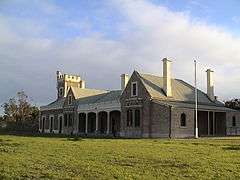 Glanville Hall Estate
Glanville Hall Estate
SAFA: 1870–1879 Football Park
Football Park
AFL: 1997–2013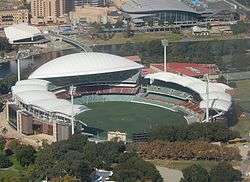
Club creed
Fos Williams authored the club's creed in 1962.[108][109]
To do this, we believe that there is great merit and noble achievement in winning a Premiership. That to be successful, each and every one of us must be active, aggressive and devoted to this cause.
We agree that success is well within our reach and have confidence that each member of both the team and management will suffer personal sacrifices for the common end.
Also, we know that, should after striving to our utmost, after giving our everything still not be successful, our efforts will become a further part of this club's enviable tradition.
Finally, we concede there can be honour in defeat, but to each of us, honourable defeat of our club and guernsey can only come after human endeavour on the playing field is completely exhausted.
Rivalries
Adelaide
Port Adelaide has a fierce rivalry with fellow South Australian AFL team Adelaide. Matches between the two teams are known as the Showdown.
The rivalry between Adelaide and Port Adelaide is often considered the best, and most bitter, in the Australian Football League with Malcolm Blight, Australian Football Hall of Fame Legend, stating in 2009 that "there is no doubt it is the greatest rivalry in football."[110]
The Showdown's intense rivalry can be traced back to Port Adelaide's pre-existing rivalries within the SANFL, particularly Norwood. The Norwood–Port Adelaide rivalry began in 1878 when the two clubs first played one another, however it was not until 1882 that the Norwood–Port Adelaide rivalry grew bitter. That year Port Adelaide's first win over Norwood, held at Adelaide Oval, was controversially overruled by the league, with a follow up game overshadowed by a misunderstanding at the gate which almost prevented Norwood players accessing the venue.[23] The Showdown rivalry also significantly draws upon the bitter, winner take all, competition for the two South Australian licences to join the AFL in the 1980s and early 1990s.
Current playing lists
| Senior list | Rookie list | Coaching staff | |||||||
|---|---|---|---|---|---|---|---|---|---|
|
|
|
Head coach Assistant coaches
Updated: 15 August 2020 | ||||||
| SANFL list | Coaching Staff | ||||||||
|---|---|---|---|---|---|---|---|---|---|
|
|
Head coach
Updated: 28th November 2019 | |||||||
- Note: Port Adelaide AFL-listed players (not selected to play AFL) are allowed to play for the SANFL squad.
Corporate
| Guernsey sponsors | ||
|---|---|---|
| Period | Front sponsor | Back sponsor |
| 1978 | Lensworth Finance | |
| 1979 | ||
| 1980 | Jetspress | |
| 1981 | ||
| 1982 | ||
| 1983 | Standard Chartered | |
| 1984 | ||
| 1985 | ||
| 1986 | ||
| 1987 | ||
| 1988 | Standard Chartered | |
| 1989 | ||
| 1990 | ||
| 1991 | ||
| 1992 | Alpine Retreat | |
| 1993 | Bee-Jays Roadlink | |
| 1994 | Seaton Hotel | Cash Converters |
| 1995 | Scott's Transport | |
| 1996 | ||
| 1997 | Vodafone | |
| 1998 | ||
| 1999 | ||
| 2000 | ||
| 2001 | ||
| 2002 | ||
| 2003 | ||
| 2004 | ||
| 2005 | ||
| 2006 | ||
| 2007 | ||
| 2008 | Bianco Construction & Industrial Supplies | |
| 2009 | ||
| 2010 | MyATM | AussieATM |
| 2011 | Soaring Securities | |
| 2012 | VIP Home Services | Foodbank |
| 2013 | Renault | VIP Home Services |
| 2014 | EnergyAustralia | Renault |
| 2015 | ||
| 2016 | ||
| 2017 | OAK | |
| 2018 | OAK | |
| 2019 | GFG Alliance^ | |
| 2020 | MG Motor | |
Administrative positions
- Chairman: David Koch
- Chief executive: Keith Thomas
- Football operations: Chris Davies
- Board members:
- Kevin Osborn (deputy chairman)
- Cos Cardone
- Gavin Wanganeen
- Ross Haslam
- Holly Ransom
- Jamie Restas
- Richard Ryan
- Trevor Thiele
- Amanda Vanstone
- Dylan Pilkington
Sponsors
Current major sponsors
Key China game sponsors
- Ausgold
- Cathay Pacific
- Shanghai Cred
- Haneco Lighting
- Four'n Twenty
Current clothing sponsor
- ISC (2013–present)
Supporters

The Port Adelaide Football Club has historically drawn its supporter base in and around historical working class Port Adelaide. However, this support has spread to many coastal locations in Adelaide (from Outer Harbour down to West Beach), in much of the inner-Western suburbs, throughout the North-Eastern suburbs in Campbelltown and Tea Tree Gully, in many of the Southern suburbs (such as Aberfoyle Park and Flagstaff Hill), as well as throughout the Adelaide Hills and country South Australia.
After historically being the largest football club in South Australia, Port Adelaide has reemerged as one of the largest sporting organisations in Australia, with over 60,000 members and an average attendance nearing 45,000 in 2015.
Supporter groups
Port Adelaide has many supporter groups, with every state or territory containing at least one supporter group. In addition, many country towns within South Australia have their own supporter group, many of which travel to both home and away games, including the Port Adelaide Cheer Squad, the Outer Army and The Alberton Crowd.[112]
Number one ticket holders
Current
- Hugh Sheridan – Australian actor and singer.
Former
- David Koch – Seven Network's Sunrise co-host, current club chairman[113]
- Stuart O'Grady – Australian professional road bicycle racer[114]
- Teresa Palmer – Australian model and actress[115]
- Bob Quinn – former Port Adelaide player[116]
- Tony Santic – owner of racehorse Makybe Diva[117]
Membership, revenue and attendance
| Year | Membership | Revenue | Ladder position | Home crowds | |||||
|---|---|---|---|---|---|---|---|---|---|
| AFL audited | Change | Average | Rank | Change | |||||
| Consolidated | Change | Minor round | Finals | ||||||
| 2010 | 29,029 | $31,920,182 | - | 16/16 | |||||
| 2011 | 32,581 | $37,017,885 | - | 15/17 | |||||
| 2012 | 35,543 | $37,885,369 | - | 16/18 | |||||
| 2013 | 39,838 | $41,588,282 | 13/18 | ||||||
| 2014 | $48,241,996 | 4/18 | |||||||
| 2015 | 54,057 | $50,794,664 | 9th | - | 4/18 | ||||
| 2016 | 53,743 | $52,768,461 | 10th | - | 39,665 | 4/18 | |||
| 2017 | 52,129 | $57,907,188 | 5th | 7th | 38,136 | 6/18 | |||
| 2018 | 54,386 | $59,000,643 | – | 38,227 | 8/18 | ||||
| 2019 | 51,951 | $58,334,901 | 10th | – | 33,950 | 8/18 | |||
Partnerships
China partnership
.jpg)
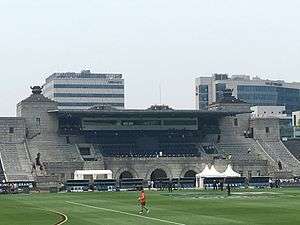
Right: Jiangwan Stadium in Shanghai where Port Adelaide have played an annual fixture since 2017.
On 14 April 2016, Port Adelaide announced a three-year multimillion-dollar partnership with leading Chinese property developer Shanghai Cred. Within this partnership, Port Adelaide will take primary responsibility for developing Australian rules football in China. The partnership will see Port Adelaide hold annual training camps and provide sponsorship in China, as well as producing AFL programs and broadcasting games in the country via China Central Television and other networks.[118] The first AFL game played for premiership points was played in May 2017 between the Gold Coast Suns and Port Adelaide.[119] Port Adelaide also runs an Australian rules football program in over 20 Chinese schools culminating in a football carnival the same week the AFL premiership match is held in Shanghai.[120]
Indigenous community

The Port Adelaide Football Club has had a long connection to the indigenous community. The Hart family who were founders of the club operated The Adelaide Milling and Mercantile Company in Port Adelaide which employed Kaurna people alongside non-indigenous workers as early as the 1850s.[121] John Hart Sr advocated for other settlers to refrain from killing and eating black swans as they were a totem of the Kaurna people.[121] Harry Hewitt was named in Port Adelaide's side when they defeated Fitzroy by two goals on Adelaide Oval in 1891 and is the clubs first known Indigenous Australian player. In 2008 the club started the Aboriginal Power Cup to help promote academic and healthy outcomes for indigenous students in South Australia.[122] Known Indigenous Port Adelaide players to have represented the senior team in the SANFL, AFL or against interstate clubs include: Ross Agius, Keiran Agius, Corey Ah Chee, Brendon Ah Chee, Karl Amon, Troy Bond, Shane Bond, Richie Bray, Peter Burgoyne Jr, Peter Burgoyne Sr, Trent Burgoyne, Shaun Burgoyne, Michael Clinch, Jason Cocaktoo, Che Cockatoo-Collins, Donald Cockatoo-Collins, Malcolm Cooper, Tobin Cox, Aaron Davey, Alwyn Davey, Fabian Francis, Joel Garner, Brett Goodes, Harry Hewitt, Wilf Huddleston, Jarman Impey, Graham Johncock, Aidyn Johnson, Nathan Krakouer, Peter Lindsay, Jarrod Lienert, Andrew McLeod, Tim Milera, Terry Milera, Harry Miller, Cameron Miller, Daniel Motlop, Marlon Motlop, Steven Motlop, Derek Murray, Allan Murray, Jake Neade, Stephen O'Brien, Michael O'Brien, Ricky O'Loughlin, Brenton Owens, Danyle Pearce, Sam Powell-Pepper, Byron Pickett, Patrick Ryder, Peter Talman, Joel Tessman, Lindsay Thomas, Wade Thompson, Gavin Wanganeen, Elijah Ware, Eugene Warrior Jnr, Eugene Warrior Snr, Luke Wilson, Chad Wingard.
Club honour boards
See Also
- List of Port Adelaide Football Club players (Pre AFL entry)
- List of Port Adelaide Football Club players (Post AFL entry)
Honour Board
Hall of Fame
| Port Adelaide Football Club | |||||||||||||||||||||||||||||||||||||||||||||
|---|---|---|---|---|---|---|---|---|---|---|---|---|---|---|---|---|---|---|---|---|---|---|---|---|---|---|---|---|---|---|---|---|---|---|---|---|---|---|---|---|---|---|---|---|---|
| Hall of Fame | |||||||||||||||||||||||||||||||||||||||||||||
Individuals
|
Greatest Team
| B: | Richard Russell | John Abley | Edward Whelan |
| HB: | Neville Hayes | Greg Phillips | Geof Motley |
| C: | Craig Bradley | Russell Ebert (vc) | John Cahill |
| HF: | Dave Boyd | Les Dayman | Harold Oliver |
| F: | Scott Hodges | Tim Evans | Bob Quinn |
| Foll: | Russell Johnston | Allan Reval | Fos Williams (c) |
| Int: | Harry Phillips | Jeffrey Potter | Peter Woite |
| Lloyd Zucker | |||
| Coach: | Fos Williams | ||
Military service
| War Roll of Honour[123] | |||
|---|---|---|---|
| Second Boer War | |||
| Kenneth McKenzie | |||
| World War I | |||
| Maurice Allingham | Frederick Badcock | Arthur Biscombe | William Boon † |
| David Bower | Howard Bungey | Hugh Challinder | Arnold Channon |
| Albert Chaplin † | Robert Coffen | Henry Davis | Clement Dayman |
| William Dempster | Henry Dewar | William 'Roy' Drummond M.M. | Edward Foggo |
| Archibald Gosling † | Matthew Healy | Horace Hoare | Samuel Howie |
| Gordon Inkster | Clarence Latimer | Lawrence Levy | William Marshall |
| Tom McDonald D.C.M | Frederick Meadows | Edward Oatey | John W. Robertson |
| Edwin Rose | Thomas Sard | Stedman Stidson | William Theodore |
| Harry Tobin | Arthur Tubel | Arthur Turner | Douglas Walsh M.C.† |
| Joseph Watson † | Edward Weeden | ||
| World War I – officials | |||
| Dr Alexander Benson | Charles Hayter | Dr Edward Morris | |
| World War II | |||
| Howard Abbott | James Allingham | Charles A. Andersen | Charles H. Andersen |
| Basil Bampton | Harold Beer | Halcombe George Brock † | Maxwell Carmichael † |
| George W.F. Chapman | Clarence Christensen | Noel Clark | John Coppin |
| Ivor Dangerfield | Lindsay Darling | Ralph Dawe | Clarance L. Dayman |
| John Dermody | Edward Dorian | James Doyle | Drozena Eden |
| Bert Edwards | James Farr | Dennis Fitzgerald | Frederick Galliford |
| Laurence Gates | Geoffrey Germein | Francis Gibaut | Arthur Gower |
| Colin Grant | Claude Greening | Donald Gregg | Colin Grimm |
| John Heaton | Colin Herbert | John Johnson | Kenneth Johnson |
| Clyde Kellaway | Peter Keough | Lyall Kretschmer | Robert Lander |
| Peter Marrett | Richard Mayne | Harold McDonald | Norman McInnes |
| Malcolm McKiggan † | Allan R.C. 'Bob' McLean | Harold Mills | Brian Moore |
| George Neaylon | John Oehme | William Owens | Alexander Pender |
| Harry Perry | Frederick Peters | James Prideaux | George U. Quinn † |
| John M. Quinn | Robert B. Quinn M.M. | Lew Roberts | Herbert Robertson |
| Bertram Robinson | Lloyd Rudd † | Leonard Salvemini | Reginald Schumann |
| John Skelley | Kenneth Slade | Gordon Temby | William Trigg |
| Arthur Tunbridge | Arthur Utting | John Wade † | Hercules Waldron |
| John White | Geoffrey Wiese | Foster Williams | John Woollard |
| World War II – officials/staff | |||
| Kenneth Aubert | Archibald Dowsett | Henry Naismith | William Adair |
| Vietnam War | |||
| Peter Chant † | Lindsay McGie | John A. Quinn | |
† denotes killed in action or died while serving
SANFL presence post AFL entry
In 1994 the Port Adelaide Football Club obtained an AFL licence, however the club had to wait until 1997 to partake in the competition as the Adelaide Crows had a clause preventing another club entering the national competition from South Australia until the end of 1996.[124] Initially Port Adelaide's 1990 proposed model was to use its SANFL side as its reserves team.[125] By the second licence tender in 1994 the club proposal was to field a single team in the AFL. After winning the AFL licence the SANFL teams backflipped and wanted a Port Adelaide side to remain in the SANFL. However the SANFL clubs did not want the reserves side to gain any use of the senior side in the AFL's resources out of fear its advantages would be too strong in the SANFL.[103] As a result for the first few years after 1997, Port Adelaide's SANFL side, which was now a separate legal entity from the Port Adelaide Football Club, was forced to train at Ethelton to ensure they would not gain any advantage using the Alberton training facilities.[103] Australian football historian John Devaney described the forced separation of Port Adelaide's SANFL and AFL operations as being "akin to the enforced splitting up of families associated with military conquest or warfare".[104]
"I keep telling this story and I hope people listen. When we tendered for the AFL we got 99.9% of our members by survey [to answer] "do you want to go into the AFL?", [they replied] "yes we do, we want to be in the best competition and that best competition was the AFL". So we go with a mandate from our members and we win the licence to go into the AFL. Port Adelaide Football Club was going into the AFL as the Port Adelaide Football Club and we had no intentions in our bid document to have a reserves side at that point in time or a presence in the SANFL because that was just too complex because of the politics. We couldn't imagine we could get one side in the AFL and have a second side in the SANFL. I can tell the story because it's true, I was there! So we win the AFL licence and then all of a sudden the opposition clubs in the SANFL were going "what does that mean? Port have gone to the AFL…that means that we won't play them anymore! That means that they won't come through the gates to watch our home games against Port anymore!…Uh, we don't like that". So all of a sudden the SANFL change the rules and go "you can have the licence but one thing you have to do is have Port Adelaide in the SANFL" and we said "Yep ok…well were not going to fight that…but it wasn't the rules when you started the exercise". What happens is the SANFL want our local side to be separate, away from Alberton, so they won't get an advantage. Anyhow, what we have now through Keith Thomas and the good work of the board and all involved, the Timmy Ginever's and the George Fiacchi's etcetera who were involved in all of that have actually got the best of both worlds now with Port Adelaide in the SANFL as our AFL reserves side."
— Brian Cunningham, Port Adelaide Football Club's CEO from 1992 until 2004 in a 2018 interview., [126]
On 20 August 2010, the "One Port Adelaide Football Club" movement was launched by former player Tim Ginever to merge Port Adelaide's AFL and SANFL operations. A website was created that claimed 50,000 signatures were needed for the merger. On 15 November 2010, all nine SANFL clubs agreed that the off-field merger between the two operations would proceed.[127][128] On 10 September 2013, Port Adelaide and the SANFL agreed to a model to allow all its AFL-listed players (not selected to play for Port Adelaide in the AFL) to play for the SANFL side. From 2015 onward, the club lost its recruiting zones and could no longer field sides in the junior SANFL competition. Port Adelaide subsequently started an Academy team composed of 18 to 22-year-olds.[129]
Port Adelaide featured in three SANFL Grand Finals in the 2010s though it lost each of them. The club will not field a team in the SANFL in the 2020 season due to AFL restrictions imposed during the COVID-19 pandemic, though it has expressed its intention to re-join the competition in 2021.[130]
Season summaries
Club achievements
| Club achievements | |||
| Competition | Level | Wins | Year won |
| AFL | Premiers | 1 | 2004 |
| Runners up | 1 | 2007 | |
| McClelland Trophy | 3 | 2002, 2003, 2004 | |
| Championship of Australia | Champions | 4 | 1890, 1910, 1913, 1914 |
| SAFA/SAFL/SANFL | Premiers | 36 | 1884, 1890, 1897, 1903, 1906, 1910, 1913, 1914, 1921, 1928, 1936, 1937, 1939, 1951, 1954, 1955, 1956, 1957, 1958, 1959, 1962, 1963, 1965, 1977, 1979, 1980, 1981, 1988, 1989, 1990, 1992, 1994, 1995, 1996, 1998, 1999 |
| Runners up | 38 | 1878, 1879, 1883, 1887, 1888, 1889, 1891, 1892, 1898, 1901, 1904, 1905, 1907, 1909, 1911, 1912, 1915, 1926, 1929, 1930, 1934, 1935, 1938, 1945, 1946, 1953, 1964, 1966, 1967, 1968, 1971, 1972, 1976, 1984, 1997, 2014, 2017, 2019 | |
| Wooden Spoons | 3 | 1886, 1896, 1900 | |
| South Australian Patriotic League | Premiers | 3 | 1916, 1917, 1942 |
| Runner up | 2 | 1943, 1944 | |
Player achievements
Competition awards
Magarey Medal (SANFL best and fairest)
|
|
AFLCA Champion Player of the Year
- 2004 – Warren Tredrea
- 2014 – Robbie Gray
AFL Rising Star (Best player under 21)
- 1997 – Michael Wilson
- 2006 – Danyle Pearce
Grand final best on ground awards
Norm Smith Medal (AFL Grand Final best on ground)
- 2004 – Byron Pickett
Jack Oatey Medal (SANFL Grand Final best on ground)
- 1981 – Russell Ebert
- 1988 – Bruce Abernethy
- 1989 – Russell Johnston
- 1990 – George Fiacchi
- 1992 – Nathan Buckley
- 1994 – Darryl Wakelin
- 1995 – Anthony Darcy
- 1996 – David Brown
- 1998 – Brett Chalmers
- 1999 – Darryl Poole
All-Australian
Sporting Life Magazine
- Bob Quinn – 1947 (captain)
- Dick Russell – 1950
- Fos Williams – 1950, 1951
- Harold McDonald – 1951, 1955
Interstate carnivals
- John Abley – 1956, 1958, 1961
- John Cahill – 1969
- Greg Phillips – 1980
- Mark Williams – 1980
- Craig Bradley – 1983, 1985
- Tony Giles – 1983
- Stephen Curtis – 1983
- Greg Anderson – 1987
- Martin Leslie – 1988
Australian Football League
- Adam Heuskes – 1997
- Gavin Wanganeen – 2001, 2003
- Matthew Primus – 2001, 2002
- Warren Tredrea – 2001, 2002, 2003, 2004
- Brett Montgomery – 2002
- Josh Francou – 2002
- Chad Cornes – 2004, 2007
- Mark Williams – 2004 (coach)
- Kane Cornes – 2005, 2007
- Brendon Lade – 2006, 2007
- Shaun Burgoyne – 2006
- Chad Wingard – 2013, 2015
- Travis Boak – 2013, 2014
- Robbie Gray – 2014, 2015, 2017, 2018
- Paddy Ryder – 2017
Club awards
John Cahill Medal (best and fairest)
Allan Robert McLean Medal (SANFL best and fairest)
Gavin Wanganeen Medal (Best player under 21)
- 2006 – Danyle Pearce
- 2007 – Justin Westhoff
- 2008 – Alipate Carlile
- 2009 – Travis Boak
- 2010 – Jackson Trengove
- 2011 – Hamish Hartlett
- 2012 – Chad Wingard
- 2013 – Ollie Wines
- 2014 – Ollie Wines
- 2015 – Ollie Wines
- 2016 – Jarman Impey
- 2017 – Sam Powell-Pepper
- 2018 – Dan Houston
- 2019 – Connor Rozee
John McCarthy Medal (Community Award)
- 2013 – Jack Hombsch
- 2014 – Brad Ebert
- 2015 – Nathan Krakouer
- 2016 – Jack Hombsch
- 2017 – Jack Hombsch
- 2018 – Justin Westhoff
- 2019 – Travis Boak
Club records
As at the end of 2017:
Overall win/loss record
- AFL – 485 matches / 248 wins / 232 losses / 5 draws (51.65%)
- SANFL – 2675 matches / 1744 wins / 882 losses / 65 draws (66.02%)
- Both leagues – 3160 matches / 1992 wins / 1114 losses / 70 draws (63.82%)
Best league record against another club
Minimum 20 league matches against a current club:
- AFL – St Kilda – 20 wins / 10 losses / 0 draws (66.67%)
- SANFL – Glenelg – 180 wins / 69 losses / 3 draws (72.02%)
Worst league record against another club
Minimum 20 league matches against a current club:
- AFL – Sydney – 9 wins / 20 losses / 0 draws (31.03%)
- SANFL – Norwood – 197 wins / 193 losses / 17 draws (50.49%)
Highest score
- AFL – 29.14 (188) vs Hawthorn, round 13, 2005, Football Park
- SANFL – 37.21 (243) vs Woodville, 19 April 1980, Football Park
Lowest score
- AFL – 3.3 (21) vs Collingwood, round 20, 2011, Football Park
- SAFA – 1.1 (7) vs North Adelaide, 5 May 1900, Alberton Oval
Greatest winning margin
- AFL – 117 points vs Hawthorn, round 13, 2005, Football Park
- SANFL – 179 points vs Woodville, 8 August 1970, Woodville Oval
Greatest losing margin
- AFL – 165 points vs Hawthorn, round 21, 2011, MCG
- SANFL – 122 points vs Norwood, 1997, Adelaide Oval
Most wins in a season
1 This record is unbreakable under the current SANFL fixturing rules (current maximum is 20 wins: 18 home-and-away plus two finals).
Fewest losses in a season
Largest home attendances (minor round)
- AFL – 53,698 at Adelaide Oval (round 3, 2017 vs Adelaide)
- AFL (excluding Showdown) – 52,505 at Adelaide Oval (round 22, 2014 vs Carlton)
- SANFL – 38,213 at Football Park (round 19, 1988 vs Sturt)
- SANFL (suburban) – 22,738 at Alberton Oval (round 11, 1977 vs Norwood)
Largest away attendances (minor round)
- AFL – 51,883 at MCG (round 1, 1997 vs Collingwood)
- SANFL – 30,618 at Adelaide Oval (round 11, 1977 vs South Adelaide)
- SANFL (suburban) – 22,015 at Unley Oval (round 9, 1968 vs Sturt)
Largest finals attendances
- AFL – 97,302 at MCG (2007 AFL Grand Final vs Geelong)
- SANFL – 66,897 (80,000 police estimate) at Football Park (1976 SANFL Grand Final vs Sturt)[46]
Longest undefeated streak
- AFL – 8 wins (round 8 → 15, 2002, round 15 → 22, 2003, round 4 → 12, 2014)
- SAFL – 33 games (21 June 1913 → 1914 → 3 July 1915)
Longest winless streak
- AFL – 11 games (round 11 → 23, 2011)
- pre-SAFA – 15 games (game 1, 1870 → game 2, 1873)
Player records
Most games played
- AFL – 300 – Kane Cornes (2001–2015)
- SANFL – 391 – Russell Ebert (1968–1978, 1980–1985)[131]
Most games coached
- AFL – 274 – Mark Williams (1999–2010)
- SANFL – 444 – Fos Williams (1950–1958, 1962–1973)
- Combined – 488 – John Cahill (SANFL: 1974–1982, 1988–1996; AFL: 1997–1998)
Most premierships as player
- SANFL – 9 – Geof Motley (1954–1959, 1962–1963, 1965)
- AFL – 1 – 2004 premiership team
Most premierships as coach
- SANFL – 10 – John Cahill (1977, 1979–81, 1988–90, 1994–96)
- AFL – 1 – Mark Williams (2004)
Most goals at Port Adelaide
- AFL – 549 – Warren Tredrea (1997–2010)
- SANFL – 1044 – Tim Evans (1975–1986)[132]
Most goals in a match
- AFL – 8 – Warren Tredrea and Jay Schulz (1998, round 7, vs Carlton, Princes Park; 2014, round 14, vs Western Bulldogs, Adelaide Oval)
- SANFL – 16 – Tim Evans (1980, round 5, vs West Adelaide)
Most goals in a season
- AFL – 81 – Warren Tredrea (2004)
- SANFL – 153 – Scott Hodges (1990)
References
- "Current details for ABN 49 068 839 547". ABN Lookup. Australian Business Register. Retrieved 4 August 2020.
- "PTV: Jack Hombsch – Jim Stynes Community Leadership Award nomination". 15 September 2015.
Port Adelaide's motto is 'We Exist to Win Premierships and Make Our Community Proud'.
- Port Adelaide – Part One: 1870 to 1918, FullPointsFooty.net
- Club Championship of Australia, FullPointsFooty.net.
- "Australian Football – Port Adelaide Football Club – Bio". australianfootball.com. Retrieved 16 October 2015.
- "The wheat statistics". South Australian Register. Adelaide, SA: National Library of Australia. 13 May 1870. p. 5. Retrieved 29 March 2015.
- South Australian Advertiser, 10 May 1870; and South Australian Chronicle and Weekly Mail, 14 May 1870.
- Whimpress, Bernard (1983). "The South Australian Football Story". SA 175. professional historians association (south australia). Retrieved 2 May 2015.
- Gyss, Trevor (2010). 1877 South Australian Football Season Records and Statistics. p. 31. ISBN 1445782928.
- "Football". The South Australian Advertiser. Adelaide: National Library of Australia. 18 June 1878. p. 7. Retrieved 2 May 2015.
- "10 things you probably don't know about the Port Adelaide Football Club… – portadelaidefc.com.au". Retrieved 29 May 2015.
- "Intercolonial Football Match". Evening Journal. XV (4410). South Australia. 3 July 1883. p. 3. Retrieved 27 April 2017 – via National Library of Australia.
- "Sporting Intelligence". The Argus. Melbourne: National Library of Australia. 25 May 1885. p. 9. Retrieved 22 November 2014.
- "Football". The South Australian Advertiser. Adelaide: National Library of Australia. 21 June 1887. p. 7. Retrieved 14 January 2015.
- "FOOTBALL". The South Australian Advertiser. Adelaide: National Library of Australia. 21 June 1887. p. 7. Retrieved 5 March 2015.
- "First of firsts: Port Adelaide v Richmond 1889 – portadelaidefc.com.au". portadelaidefc.com.au. Retrieved 16 October 2015.
- "FOOTBALL". The Express and Telegraph. XXVIII (8, 303). South Australia. 3 August 1891. p. 4. Retrieved 22 July 2017 – via National Library of Australia.
- Devaney, John. "Port Adelaide". Australian Football. Retrieved 14 May 2015.
- "Football". Adelaide Observer. National Library of Australia. 26 April 1902. p. 20. Retrieved 28 December 2014.
- "A Football Dispute". The Advertiser. Adelaide: National Library of Australia. 4 September 1902. p. 4. Retrieved 30 May 2015.
- "Football". The Register. Adelaide: National Library of Australia. 9 September 1902. p. 6. Retrieved 29 December 2014.
- "Football". The Register. Adelaide: National Library of Australia. 9 September 1902. p. 6. Retrieved 30 May 2015.
- "FOOTBALL". Evening Journal. XLIV (12305). South Australia. 16 September 1910. p. 6 (SPECIAL SPORTS EDITION). Retrieved 30 October 2018 – via National Library of Australia.
- "Port Adelaide v. Sydney". The Evening News. Sydney: National Library of Australia. 7 June 1907. p. 3. Retrieved 5 May 2015.
- Devaney, John. "Port in Perth – Port Adelaide's 1910 WA tour". australianfootball.com. Retrieved 7 October 2019.
- "Australian Football". australianfootball.com. Retrieved 16 October 2015.
- "Football". The Barrier Miner. Broken Hill, NSW: National Library of Australia. 16 August 1910. p. 2. Retrieved 5 May 2015.
- Devaney, John (2008). SA Football Companion. Full Points Footy's. p. 431.
- "Championship football port adelaide invincible soundly defeat combined league team". Daily Herald. 15 October 1914. p. 5. Retrieved 13 July 2015.
- "Australian Football – Angelo Congear – Player Bio". australianfootball.com. Retrieved 16 October 2015.
- "FOOTBALL". The Express and Telegraph. LIX (17, 627). South Australia. 4 May 1922. p. 6 (5 O'CLOCK EDITION SPORTS NUMBER). Retrieved 8 October 2018 – via National Library of Australia.
- "Family tree. Details of William Harold Oliver (1891–1958)". users.on.net. Retrieved 16 October 2015.
- "Play and Players". Daily Herald. Adelaide: National Library of Australia. 4 August 1922. p. 7. Retrieved 18 March 2015.
- "FOOTBALL". Daily Herald. XIII (3879). South Australia. 24 August 1922. p. 3. Retrieved 22 July 2017 – via National Library of Australia.
- "Australian Football – Port Adelaide Football Club – Stats". australianfootball.com. Retrieved 22 May 2015.
- Wood, John (1991). Bound for Glory. Adelaide: Largs Bay Printers. p. 6.
- Wood, John (1991). Bound for Glory. p. 12.
- Agius, Matthew (24 April 2014). "Port Adelaide servicemen in war".
- "Port-Torrens Wins Again". The Advertiser. Adelaide: National Library of Australia. 28 September 1942. p. 7. Retrieved 24 January 2015.
- Devaney, John. "Haydn Bunton Snr".
- Wood, John (1991). Bound for Glory. Port Adelaide: Largs Bay Printers. p. 46. ISBN 0959316213.
- "1955 Exhibition Match vs Port Adelaide".
- "1955 Exhibition Match vs Port Adelaide". demonwiki.org. 30 May 2014. Retrieved 20 January 2015.
- Port Adelaide Football Club Annual Report. Port Adelaide Football Club. 1956. p. 6.
- "1965 SANFL season".
- Norton, Daniel (2013). Port Adelaide Football Club – 2013 Season Guide. Adelaide: Bowden Group. p. 28.
- "1977 SANFL season".
- Russell Ebert, 1977 SANFL Grand Final – Port Adelaide vs. Glenelg.
- "Australian Football – Port+Adelaide Football Club – Bio". australianfootball.com. Retrieved 16 October 2015.
- 'Port Adelaide Football Club Inc. Annual Report and Balance Sheet Season 1982', page 11
- "Revisiting the South Australian license saga of 1991". The Roar. Retrieved 16 October 2015.
- "Stateline South Australia". Australian Broadcasting Corporation. Retrieved 16 October 2015.
- "1990 SANFL season".
- "Revisiting the South Australian license saga of 1991". The Roar. Retrieved 16 October 2015.
- John P. Devaney Full points footy: encyclopedia of Australian football clubs Lulu, 2009 pp 400 ISBN 0-9556897-0-8
- George Fiacchi, 1990 SANFL Grand Final – Port Adelaide vs. Glenelg, Channel 9.
- Rucci, Michelangelo (20 September 2012). "It's bye bye Port Adelaide". Adelaide Advertiser. Retrieved 13 May 2015.
- Tim Lane, 2004 AFL Grand Final – Port Adelaide vs. Brisbane, Channel 10.
- It's not a snub – AFL still in the wings Archived 30 September 2011 at the Wayback Machine TPFP 19 March 2009
- Port Adelaide gets $2.5 million SANFL funding AFL 20 May 2009
- Power AFL grant AFL, 15 June 2009
- Will Swanton, Courtney Walsh (4 March 2014). "And the big man flies".
- "Primu appointed – Official AFL website of the Port Adelaide Football Club". Portadelaidefc.com.au. 11 July 2010. Archived from the original on 16 June 2011. Retrieved 11 July 2010.
- "The official website of the Australian Football League – AFL.com.au". afl.com.au. Retrieved 16 October 2015.
- "Boak to lead new era at Port Adelaide". portadelaidefc.com.au. Retrieved 16 October 2015.
- Watkin, Lucy (30 June 2017). "A history of your AFL club's jumper". Herald Sun.
- "PORT ADELAIDE V. GOLDFIELDS". Kalgoorlie Western Argus. XVI (822). Western Australia. 9 August 1910. p. 23. Retrieved 5 November 2017 – via National Library of Australia.
- Fos Williams, 1981 SANFL Grand Final broadcast, NWS9 Adelaide, 1981
- "A few final Port jumper saga notes". The Advertiser. Adelaide. 8 September 2014. Retrieved 6 October 2019.
- "GOSSIP OF THE GAME". The News. XIII (1, 898). South Australia. 15 August 1929. p. 14 (HOME EDITION). Retrieved 11 February 2019 – via National Library of Australia.
- "Premier SA club plans AFL move". The Canberra Times. National Library of Australia. 1 August 1990. p. 38. Retrieved 18 March 2015.
- "Club statement re: heritage guernsey". 1 May 2007.
- "Port Adelaide to wear Black and White" from the Official AFL Website of the Port Adelaide Football Club. Retrieved 14 May 2007.
- Karen Lyon, Alan Shiell and Bill McDonald, Port, Pies in black-and-white blue, The Age.
- Dwayne Russell,2003 AFL Round 19 Port Adelaide vs. Carlton, Fox Footy.
- Leigh Matthews, 2014 AFL Elimination Final – Port Adelaide vs Richmond, Channel 7.
- Rucci, Michelangelo (16 July 2014). "Port Adelaide Denied Opportunity to Wear Heritage Jumper at First Friday Night Match at Adelaide Oval".
- Dennis Cometti, 2014 AFL Elimination Final – Port Adelaide vs Richmond, Channel 7.
- Shaw, Tony (4 May 2019). "Why a Collingwood legend "doesn't care" if Port Adelaide wear 'prison bar' jumper". 3AW.
- "Club greats rally behind push for Port Adelaide to wear its prison bar guernsey in 2020". The Advertiser. 27 November 2018.
- "Why a Collingwood legend "doesn't care" if Port Adelaide wear 'prison bar' jumper". 3AW. 4 May 2019. Retrieved 29 May 2019.
- Rucci, Michaelangelo (20 February 2019). "After the Port Adelaide resolves whether to stay by tradition with its captain, the Power can prepare for an even more emotive battle". The Advertiser. Retrieved 29 May 2019.
- "#BringBackTheBars on Instagram: "Mark Bickley on FIVEaa supporting the wishes of Port Adelaide fans wanting to resume wearing the clubs most famous guernsey to coincide…"". Instagram. Retrieved 29 May 2019.
- "#BringBackTheBars on Instagram: "Sydney Swans star Dale Lewis sharing his view on what should happen with Port Adelaide's traditional guernsey. Make sure you LIKE our…"". Instagram. Retrieved 29 May 2019.
- "#BringBackTheBars on Instagram: "This Friday will be Travis Boak's 250th game. To celebrate we are revisiting his thoughts on our most famous guernsey. To support the…"". Instagram. Retrieved 29 May 2019.
- "#BringBackTheBars on Instagram: "Robbie Gray shared his thoughts this week on our famous guernsey hoping the club "can get it done"...only one way to do this, SIGN and…"". Instagram. Retrieved 29 May 2019.
- Wines, Ollie (24 November 2018). "My favourite jumper I've worn throughout my whole football career!". @wines16. Retrieved 29 May 2019.
- "Jay Weatherill". facebook.com. Retrieved 29 May 2019.
- "#BringBackTheBars on Instagram: "Our petition gained a lot of momentum after the #BringBackTheBars night. Reaching this milestone is testament to the effort of the @PAFC…"". Instagram. Retrieved 6 October 2019.
- "AFL 2019: Port Adelaide will wear prison bars outfit in two matches for season 2020". Fox Sports Australia. 14 August 2019.
- "Thomas: No agreement in place to prevent Prison Bars post 2020". portadelaidefc.com.au. Retrieved 7 October 2019.
- "David Koch Wants A Port Adelaide 150th Anniversary "Reboot" Next Year". FiveAA. 1 June 2020. Retrieved 2 June 2020.
- "AFL 2020: Port Adelaide prison bar jumper clash with Collingwood Eddie McGuire vs David Koch, Footy Classified". Fox Sports. 3 June 2020. Retrieved 4 June 2020.
- "Port Adelaide to seek Prison Bar approval beyond 2020". portadelaidefc.com.au. Retrieved 4 June 2020.
- Faulkner, Andrew (4 June 2020). "Nathan Buckley backs Port Adelaide's prison bars for Showdown". The Australian.
- "General News". The Express and Telegraph. VI (2, 018). South Australia. 19 August 1870. p. 2 (2nd Ed.). Retrieved 5 January 2018 – via National Library of Australia.
- "Song for the Port Adelaide Football Club". Port Adelaide News. V (304). South Australia. 7 July 1882. p. 8. Retrieved 5 January 2018 – via National Library of Australia.
- 1921 Port Adelaide premiership reunion dinner menu, 1965.
- Rucci, Michaelangelo (14 April 2014). "Staying Power: jumper lead to start off" (PDF). The Advertiser. Retrieved 5 January 2018.
- Club Song Port Adelaide Football Club
- "Pitjantjatjara translation for Port Adelaide club song – portadelaidefc.com.au". portadelaidefc.com.au. Retrieved 4 January 2018.
- McGuire, Michael. "Liverpool brings its football and its famous song to Adelaide Oval". The Advertiser. Retrieved 19 July 2015.
- "From the CEO: September 3, 2015". portadelaidefc.com.au. Retrieved 26 October 2017.
- "Australian Football – Port Adelaide Football Club – Bio". australianfootball.com. Retrieved 27 September 2017.
- "A history of Port Adelaide's logos". portadelaidefc.com.au. 10 October 2019.
- "Port Adelaide launch 150th anniversary season with commemorative logo". portadelaidefc.com.au. 13 October 2019.
- "Alberton Oval – Official AFL website of the Port Adelaide Football Club". Portadelaidefc.com.au. Retrieved 14 June 2010.
- The Creed Port Adelaide Football Club
- AFL 360: The Port Adelaide Creed YouTube (originally broadcast by Fox Footy)
- "Why we win the derby Showdown". Retrieved 15 April 2017.
- http://www.portadelaidefc.com.au/sanfl/season-2014/players
- "Port Adelaide Supporter Groups – portadelaidefc.com.au". portadelaidefc.com.au. Archived from the original on 27 June 2015. Retrieved 11 July 2015.
- Joint No.1 Ticket Holders thepowerfromport.com.au 30 January 2008
- Riding the roller-coaster The Age 2 January 2008
- Teresa Palmer Power's No. 1 Archived 2 September 2010 at the Wayback Machine AFL News 30 January 2008
- Bob Quinn 1915–2008 Official website of the Port Adelaide Football Club, 12 September 2008
- AFL: Diva trainer Port's No. 1 fan 24 March 2006
- "Subscribe to The Australian". The Australian. Retrieved 22 October 2016.
- McClure, Sam (27 September 2016). "AFL 2016 finals: Port Adelaide heading to China in late May as AFL ticks off on international game". The Age. Retrieved 22 October 2016.
- "Power Footy". portadelaidefc.com.au. Retrieved 8 July 2019.
- "Hart's Mill Complex | SA History Hub". sahistoryhub.com.au. Retrieved 21 June 2019.
- "Aboriginal Power Cup". aboriginalpowercup.com.au. Retrieved 21 June 2019.
- "War Honour Roll". portadelaidefc.com.au. Retrieved 6 October 2019.
- Rucci, Michaelangelo (14 December 1994). "Premiers SA's Second Team". The Advertiser (Adelaide). p. 1-2.
- "SA rebel club's entry into AFL hinges on Monday meeting". The Canberra Times. 64 (20, 203). Australian Capital Territory, Australia. 4 August 1990. p. 12 (EMPLOYMENT). Retrieved 27 October 2017 – via National Library of Australia.
- Cunningham, Brian (19 March 2018). "Life Of Brian! – Ep. 6.06 BigFooty Power AFL podcast".
- Stop Press! One Club has been approved! See you at Alberton Oval at 11am Tuesday 16 November! #pafc Archived 25 January 2014 at the Wayback Machine
- One PAFC – Official AFL Website of the Port Adelaide Football Club
- "Statement: Port Adelaide accepts SANFL invitation". portadelaidefc.com.au. Retrieved 16 October 2015.
- "Statement – 2020 SANFL participation". Port Adelaide FC. 12 May 2020.
- "Australian Football – Russell Ebert – Player Bio". australianfootball.com. Retrieved 6 October 2019.
- "Australian Football – Tim Evans – Player Bio". australianfootball.com. Retrieved 28 May 2017.
External links
| Wikimedia Commons has media related to Port Adelaide Football Club. |
